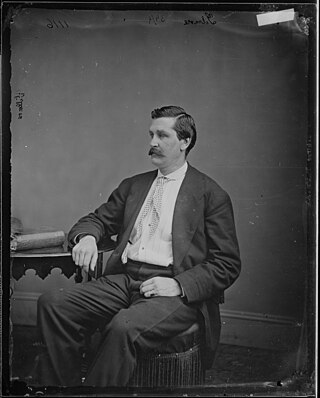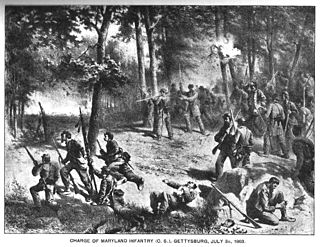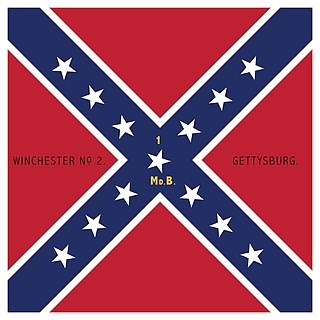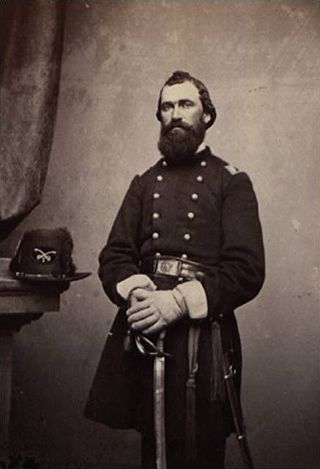
The Battle of Moorefield was a cavalry battle in the American Civil War, which took place on August 7, 1864. The fighting occurred along the South Branch of the Potomac River, north of Moorefield, West Virginia, in Hardy County. The National Park Service groups this battle with Early's Washington Raid and operations against the B&O Railroad, and it was the last major battle in the region before General Philip Sheridan took command of Union troops in the Shenandoah Valley. This Union triumph was the third of three major victories for Brigadier General William W. Averell, who performed best when operating on his own.

Harry Ward Gilmor served as the Baltimore City Police Commissioner, head of the Baltimore City Police Department in the 1870s, and a Confederate cavalry officer during the American Civil War. Gilmor's daring raids, including Gilmor's Raid through northern and central Maryland in July 1864 during the third major Confederate invasion of the North gained his partisans fame as "Gilmor's Raiders".
The town of Romney, Virginia, traded hands between the Union Army and Confederate States Army no fewer than 10 times during the American Civil War, assuming the occupying force spent at least one night in the town. The story of the small town is emblematic of the many military campaigns that swept through western Virginia and, later, the new state of West Virginia.

The U.S. state of West Virginia was formed out of western Virginia and added to the Union as a direct result of the American Civil War, in which it became the only modern state to have declared its independence from the Confederacy. In the summer of 1861, Union troops, which included a number of newly formed Western Virginia regiments, under General George McClellan, drove off Confederate troops under General Robert E. Lee. This essentially freed Unionists in the northwestern counties of Virginia to form a functioning government of their own as a result of the Wheeling Convention. Before the admission of West Virginia as a state, the government in Wheeling formally claimed jurisdiction over all of Virginia, although from its creation it was firmly committed to the formation of a separate state.

McNeill's Rangers was an independent Confederate military force commissioned under the Partisan Ranger Act (1862) by the Confederate Congress during the American Civil War. The 210 man unit was formed from Company E of the 18th Virginia Cavalry and the First Virginia Partisan Rangers. After the repeal of the Act on February 17, 1864, McNeill's Rangers was one of two partisan forces allowed to continue operation, the other being 43rd Battalion Virginia Cavalry. Both of these guerrilla forces operated in the western counties of Virginia and West Virginia. The Rangers were known to exercise military discipline when conducting raids. However, many Union generals considered Captain John Hanson McNeill (1815–1864) and his men to be "bushwhackers," not entitled to protection when captured, as was the case with other prisoners of war.

The 6th South Carolina Cavalry Regiment was a regiment of cavalry in the Confederate States Army during the American Civil War. They were from the state of South Carolina and served at various times in both the Eastern and Western theaters.
Galvanized Yankees was a term from the American Civil War denoting former Confederate prisoners of war who swore allegiance to the United States and joined the Union Army. Approximately 5,600 former Confederate soldiers enlisted in the United States Volunteers, organized into six regiments of infantry between January 1864 and November 1866. Of those, more than 250 had begun their service as Union soldiers, were captured in battle, then enlisted in prison to join a regiment of the Confederate States Army. They surrendered to Union forces in December 1864 and were held by the United States as deserters, but were saved from prosecution by being enlisted in the 5th and 6th U.S. Volunteers. An additional 800 former Confederates served in volunteer regiments raised by the states, forming ten companies. Four of those companies saw combat in the Western Theater against the Confederate Army, two served on the western frontier, and one became an independent company of U.S. Volunteers, serving in Minnesota.

The 35th Virginia Cavalry Battalion, also known as White's Battalion, White's Rebels and the Comanches, was a Confederate cavalry unit during the American Civil War raised by Elijah V. White in Loudoun County, Virginia in the winter of 1861-62. The battalion was initially raised as border guards along the Potomac River below Harpers Ferry but were ultimately mustered into regular service as part of the Laurel Brigade. Despite this, they continued to play a conspicuous role in the ongoing partisan warfare in Loudoun throughout the war. The battalion was particularly notable during the 1863 Gettysburg Campaign, when it played a prominent role in the Battle of Brandy Station and subsequently conducted a series of raids on Union-held railroads and defensive positions in Maryland and Pennsylvania. The 35th was the first Confederate unit to enter Gettysburg, Pennsylvania.

The 7th Virginia Cavalry Regiment also known as Ashby's Cavalry was a Confederate cavalry regiment raised in the spring of 1861 by Colonel Angus William McDonald The regiment was composed primarily of men from the counties of the Shenandoah Valley as well as from the counties of Fauquier and Loudoun. Two companies contained men from the border counties of Maryland.
The Thirteenth Pennsylvania Reserve Regiment, also known as the 42nd Pennsylvania Volunteer Infantry, the 1st Pennsylvania Rifles, Kane's Rifles, or simply the "Bucktails," was a volunteer infantry regiment that served in the Union Army during the American Civil War. It was a part of the famed Pennsylvania Reserve division in the Army of the Potomac for much of the early and middle parts of the war, and served in the Eastern Theater in a number of important battles, including Antietam, Fredericksburg, and Gettysburg.

The Maryland Line in the Army of the Confederate States of America was made up of volunteers from Maryland who, despite their home state remaining in the Union, fought for the Confederate States of America during the American Civil War. Of approximately 25,000 Marylanders who volunteered, most fought in the Army of Northern Virginia, and it was not until late in 1863 that a Maryland Line in the CSA was formally created. However, by this late stage in the war, few men wished to leave the units they had fought alongside for more than two years, and the exiles' dream of an independent Maryland Line in the Confederate army would never be fully realized.

The 11th Virginia Cavalry Regiment was a cavalry regiment raised in Virginia for service in the Confederate States Army during the American Civil War. It fought mostly with the Army of Northern Virginia.

The 18th Virginia Cavalry Regiment was a cavalry regiment raised in Virginia for service in the Confederate States Army during the American Civil War. It fought with the Army of Northern Virginia, in southwest Virginia, and in the Shenandoah Valley.

The 34th Virginia Cavalry Battalion was a cavalry battalion raised in the Appalachian mountain region of southwestern Virginia as well as adjoining areas of what became West Virginia as well as Tennessee, Kentucky and North Carolina for service in the Confederate States Army during the American Civil War. It fought in western Virginia, East Tennessee, with the Army of Northern Virginia and the Shenandoah Valley.

The 37th Virginia Cavalry Battalion was a cavalry battalion raised in Virginia for service in the Confederate States Army during the American Civil War. It fought mostly in western Virginia and the Shenandoah Valley.

The 1st Maryland Infantry Regiment was a regiment of the Confederate army, formed shortly after the commencement of the American Civil War in April 1861. The unit was made up of volunteers from Maryland who, despite their home state remaining in the Union during the war, chose instead to fight for the Confederacy. The regiment saw action at the First Battle of Manassas, in the Shenandoah Valley Campaign, and in the Peninsular Campaign. It was mustered out of service in August 1862, its initial term of duty having expired. Many of its members, unable or unwilling to return to Union-occupied Maryland, went on to join a new regiment, the 2nd Maryland Infantry, CSA, which was formed in its place.

The 2nd Maryland Infantry Regiment, was a Confederate infantry regiment made up of volunteers from Maryland who, despite their home state remaining loyal to the Union during the American Civil War, chose instead to fight for the Confederacy. The regiment was largely made up of volunteers from the 1st Maryland Infantry, CSA, which was disbanded in August 1862, its initial term of duty having expired. They saw action at many of the fiercest battles of the Civil War, taking part in the brutal fighting at Culp's Hill at the Battle of Gettysburg. The unit suffered such severe casualties during the war that, by the time of General Robert E. Lee's surrender at Appomattox Court House on April 9, 1865, only around forty men remained.
The 3d Arkansas Cavalry Regiment (1861–1865) was a Confederate Army Cavalry regiment during the American Civil War.

Jacob C. Higgins (1826–1893) was a commander of Pennsylvania troops who participated in both major military conflicts of his time, the Mexican–American War and the American Civil War. Among his Civil War commands, he guided the 125th Pennsylvania Infantry regiment under heavy fire during the Battle of Antietam and likewise during the Battle of Chancellorsville. Following the muster out and return home of the 125th PA, the Gettysburg Campaign sent cavalry under Confederate General John D. Imboden to threaten vital railroad resources at Altoona and iron production facilities in the Juniata River watershed; in response, Emergency Militia was organized by Colonel Higgins and minimized this northwestern incursion.












